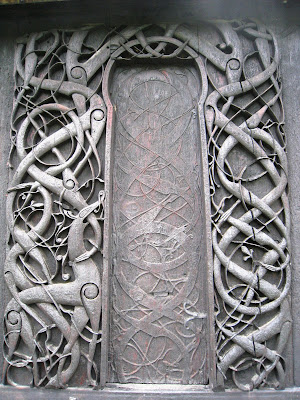The first incarnation of this monument dates back to 1040, when Norse mythology merged with Christian ideology to create something of an enigma, an edifice between past and present, between sky and sea. The swirling carvings on the exterior walls date back to this time, a writhing mass of dragons and snakes, their tales slender vegetal forms, fought by the fanged Urnes animal. These elegant forms blend the dragons of Viking folklore with those of Palestinian poetry, but also encourage the congregation inwards, to escape the endless battle between the forces of nature, and to seek solace with God.
And it is inside where the magic of this place is revealed, six columns of dark red pine rising to the roof, topped with further carvings of animal and vegetal matter. The grace of god has kept this place standing above the waters, in that he blessed the timber with the strength of iron and the carpenters with the brains of Thor. For these columns bear the hallmarks of Viking craftsmanship, the very masts of their ships. A tree is stripped of its leaves and branches, but left to die in a vertical position, roots still attached. And for ten years it remains: the resin rises to impregnate the timber, the blistering cold of midwinter dries the wood, and the already compact slow grown rings of the trunk are forged like chainmail.This wood remains today, almost one thousand years later, when the trees that bore it are long dead and decomposed, when its carpenters are beyond dust, but whose powerful message rings true today, life as a perpetual battle between the forces of nature, of water and wind, of tooth and claw.



No comments:
Post a Comment